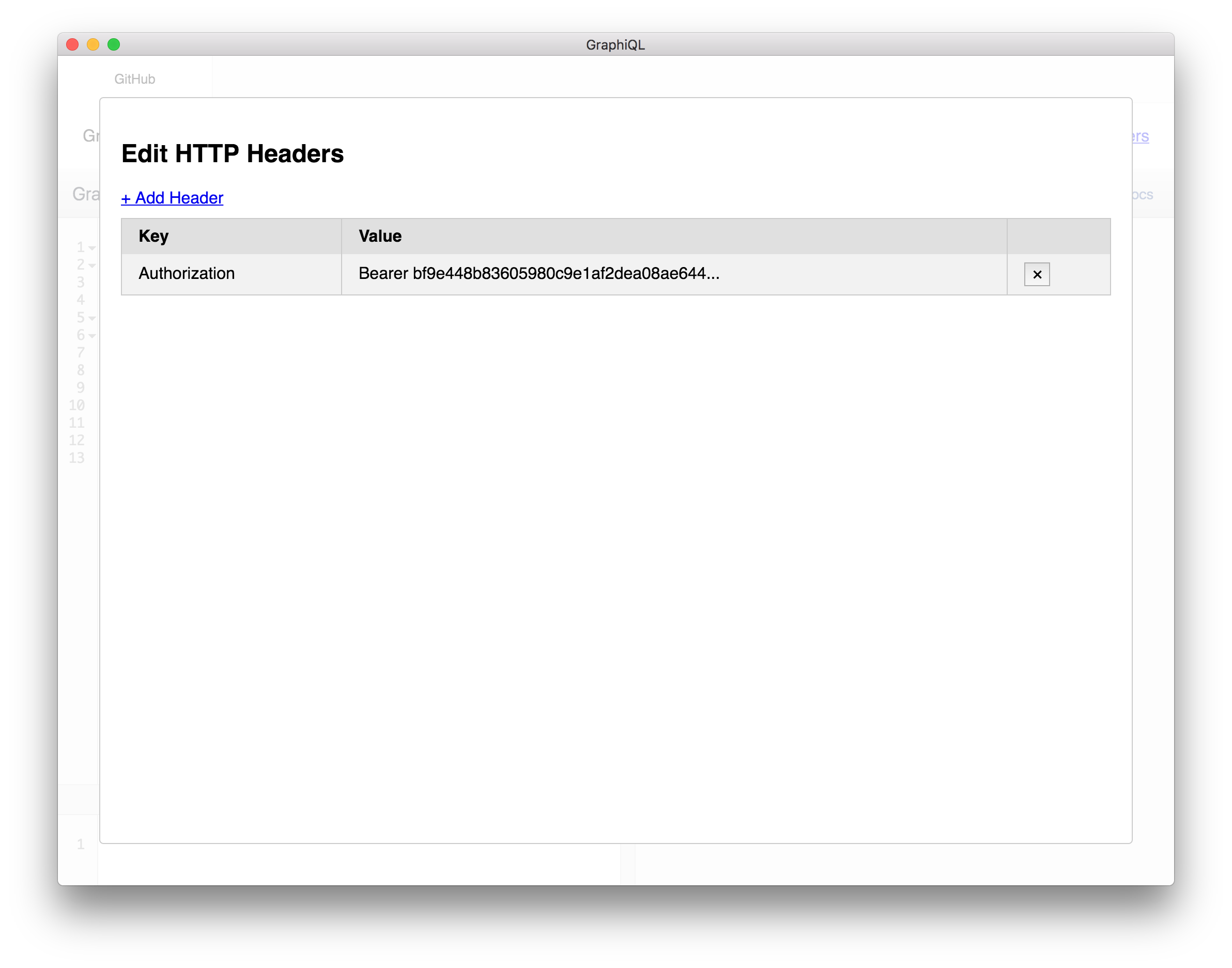About the GraphQL Explorer
GraphiQL, also referred to in this documentation as the GraphQL Explorer, is a "graphical interactive in-browser GraphQL IDE."
Using GraphiQL
To use the GraphiQL app, download and install it from https://github.com/skevy/graphiql-app.
Configuring GraphiQL
- Get an OAuth token.
- Launch GraphiQL.
- In the upper-right corner of GraphiQL, click Edit HTTP Headers.
- In the Key field, enter
Authorization. In the Value field, enterBearer <token>, where<token>is your generated OAuth token.
- Click the checkmark to the right of the token to save it.
- To return to the editor, click outside of the Edit HTTP Headers modal.
- In the GraphQL Endpoint field, enter
http(s)://<em>[hostname]</em>/api/graphql. - In the Method dropdown menu, select POST.
Note: For more information about why POST is the method, see "Communicating with GraphQL."
You can test your access by querying yourself:
query {
viewer {
login
}
}
If everything worked correctly, this will display your login. You're all set to start making queries.
Accessing the sidebar docs
All types in a GraphQL schema include a description field compiled into documentation. The collapsible Docs pane on the right side of the Explorer page allows you to browse documentation about the type system. The docs are automatically updated and will drop deprecated fields.
The Docs sidebar contains the same content that is automatically generated from the schema under "Reference," though it is formatted differently in places.
Using the variable pane
Some example calls include variables written like this:
query($number_of_repos:Int!){
viewer {
name
repositories(last: $number_of_repos) {
nodes {
name
}
}
}
}
variables {
"number_of_repos": 3
}
This is the correct format to submit the call via a cURL POST (as long as you escape newlines).
If you want to run the call in the Explorer, enter the query segment in the main pane and the variables in the Query Variables pane below it. Omit the word variables from the Explorer:
{
"number_of_repos": 3
}
Requesting support
For questions, bug reports, and discussions about aplicativo GitHubs, aplicativo OAuths, and API development, explore the Fórum de Suporte e Desenvolvimento de API GitHub. The forum is moderated and maintained by GitHub Enterprise staff, but questions posted to the forum are not guaranteed to receive a reply from GitHub Enterprise staff.
Consider reaching out to GitHub Support directly using the contact form for:
- guaranteed response from GitHub Enterprise staff
- support requests involving sensitive data or private concerns
- feature requests
- feedback about GitHub Enterprise products
Troubleshooting errors
Because GraphQL is introspective, the Explorer supports:
- Intelligent typeaheads aware of the current schema
- Validation error previews as you type
If you enter a query that is not well-formed or does not pass schema validation, a popup warns you of an error. If you run the query, the error returns in the response pane.
A GraphQL response contains several keys: a data hash and an errors array.
{
"data": null,
"errors": [
{
"message": "Objects must have selections (field 'nodes' returns Repository but has no selections)",
"locations": [
{
"line": 5,
"column": 8
}
]
}
]
}
It's possible you might run into an unexpected error that is not related to the schema. If this happens, the message will include a reference code you can use when reporting the issue:
{
"data": null,
"errors": [
{
"message": "Something went wrong while executing your query. This is most likely a GitHub bug. Please include \"7571:3FF6:552G94B:69F45B7:5913BBEQ\" when reporting this issue."
}
]
}
Note: GitHub recommends checking for errors before using data in a production environment. In GraphQL, failure is not total: portions of GraphQL queries may succeed while others fail.